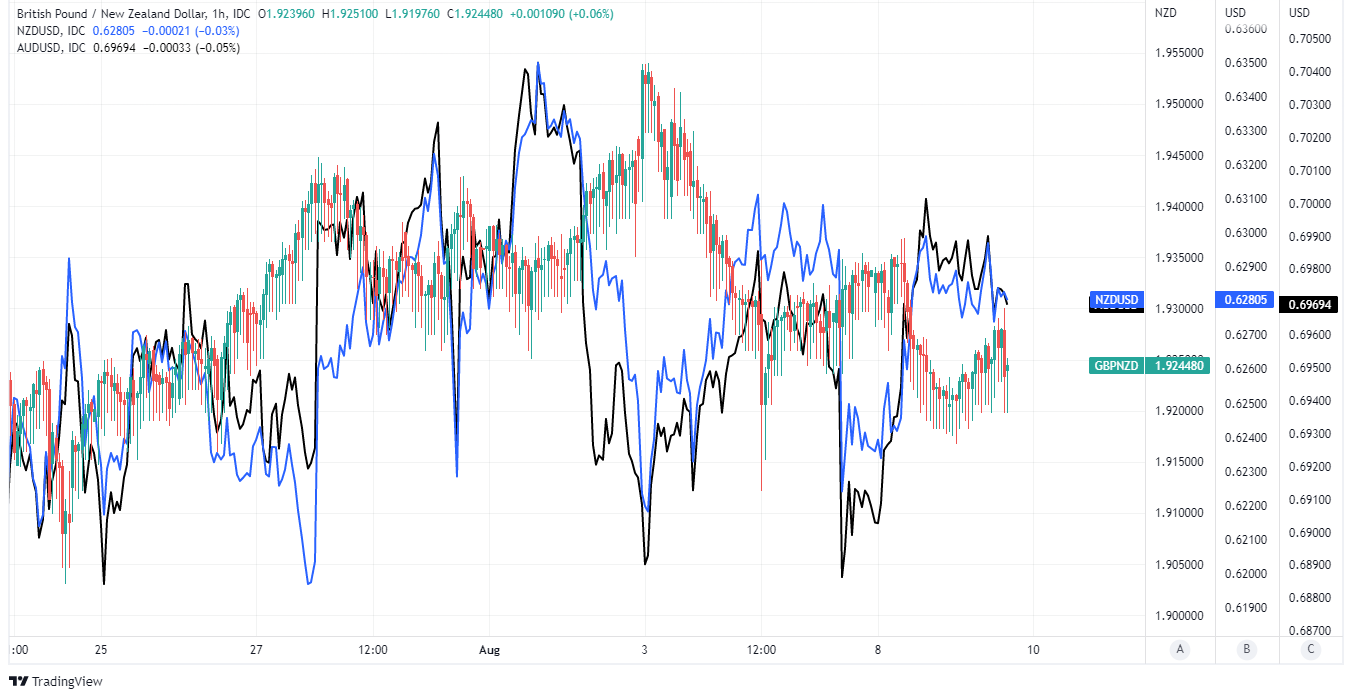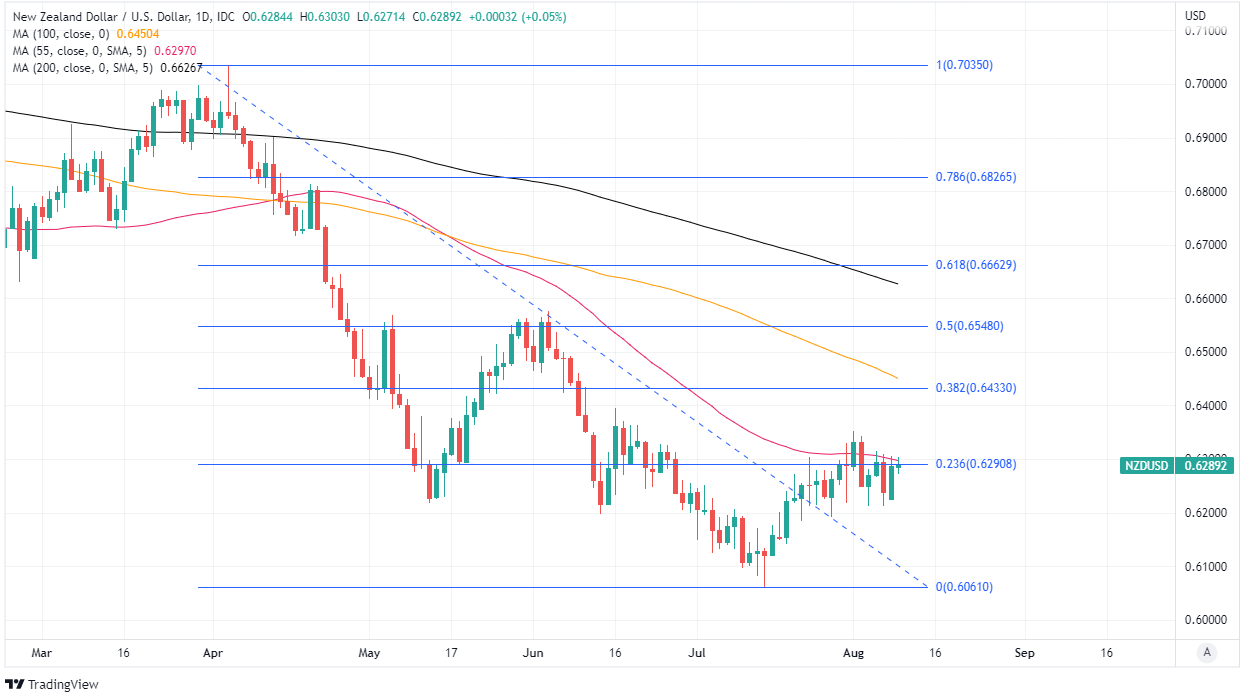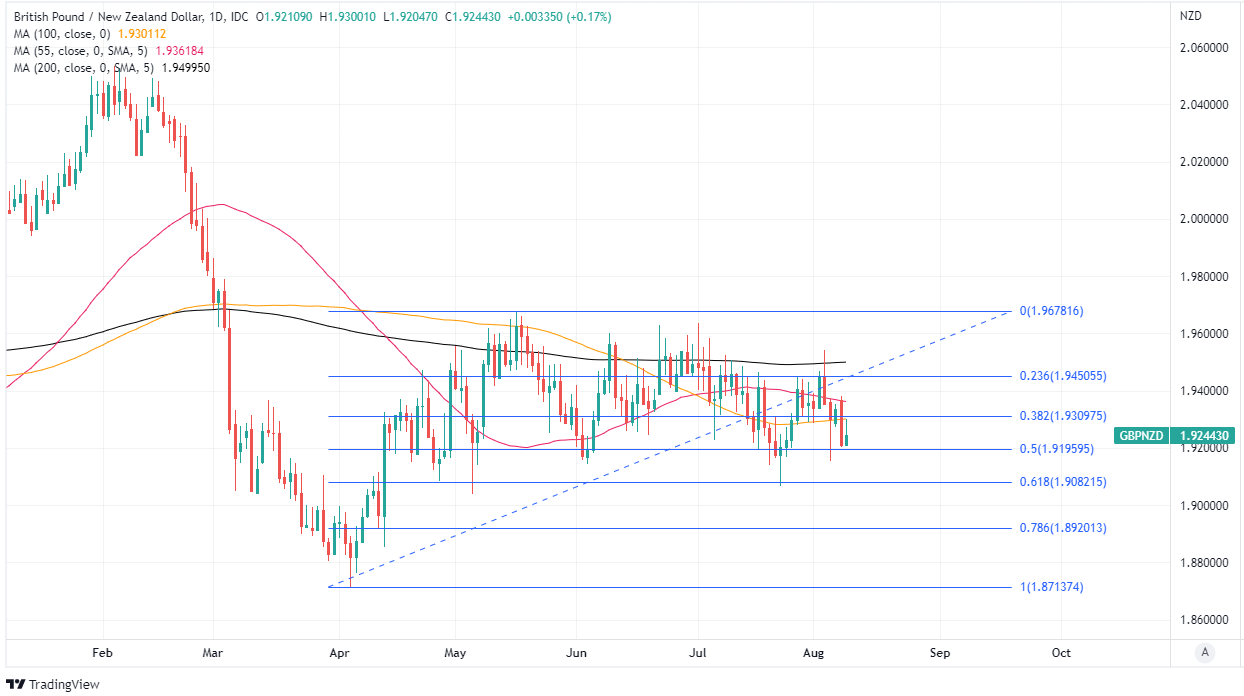GBP/NZD Rate at Risk of Slipping Back Below 1.92
- Written by: James Skinner
- GBP/NZD’s rebound could lose momentum above 1.93
- Risk of slippage below 1.92 if NZD/USD breaks higher
- Kiwi wages, resilient economy supportive of NZD/USD
- U.S. CPI & USD eyed in quiet period for UK & NZ data

Image © Adobe Stock
The Pound to New Zealand Dollar rate received a bid from the market when falling back near to four-month lows early in the new week but would risk slipping back beneath the nearby 1.92 level if the Kiwi is able to build further on a tentative rebound against the U.S. Dollar in the days ahead.
New Zealand’s Dollar ceded ground to Sterling on Tuesday following a strong start to the week in which it rose alongside the Australian Dollar while pushing GBP/NZD back near to the round number of 1.92, which coincides closely with a technical support level for the Pound.
“The latest bout of NZD strength looks to be on the back of the stronger AUD, which is back on the front foot as markets digest solid Chinese trade data,” says David Croy, a strategist at ANZ.
“Looking ahead, it seems a stretch to expect the NZD to go too far ahead of key US July CPI data out tomorrow night. This data is set to be complicated as while we may see a moderation in headline annual inflation, monthly core readings are expected to remain elevated,” Croy said on Tuesday.
Reports of China’s latest record trade surplus were widely cited for the outperformance of the antipodean currencies early this week.
 Above: GBP/NZD shown at hourly intervals alongside NZD/USD and AUD/USD. Click image for closer inspection.
Above: GBP/NZD shown at hourly intervals alongside NZD/USD and AUD/USD. Click image for closer inspection.
Compare GBP to NZD Exchange Rates
Find out how much you could save on your pound to New Zealand dollar transfer
Potential saving vs high street banks:
NZ$53.50
Free • No obligation • Takes 2 minutes
Monday's price action came almost alongside a Reserve Bank of New Zealand (RBNZ) survey suggesting that Kiwis’ expectations for future inflation declined during the recent quarter.
“The RBNZ has been losing sleep about rising inflation expectations given they can add a self-sustaining process to inflation, as firms and workers factor in higher expected future inflation into wage and price-setting behaviour,” says Mike Jones, an economist at ASB Bank.
“There’s still work to do for the RBNZ in realigning domestic demand with constrained supply – so rate hikes will continue with another 50bps next week – but the data should scratch out speculation of a larger 75bps hike,” Jones and colleagues said following the release.
Falling inflation expectations would be welcomed by the RBNZ but would be unlikely to keep it from lifting New Zealand’s main interest rate from 2.5% to 3% next week, making it the highest among advanced economies, and in part because of the brisk pace at which wage packets are growing.
“Average ordinary time hourly earnings increased to $36.97 (up 6.4 percent). Private sector ordinary time hourly earnings increased by 7.0 percent, to $35.16. Public sector ordinary time hourly earnings increased by 4.4 percent, to $44.12,” Statistics New Zealand said last Wednesday.
 Source: Statistics New Zealand. Click image for closer inspection.
Source: Statistics New Zealand. Click image for closer inspection.
Statistics New Zealand data out last week showed that wage growth for job hoppers and Kiwi workers who receive promotions is running at almost twice the average level for workers who remain within present posts.
The latest wage figures mean that for some workers in New Zealand there hasn’t been very much inflation at all and may help to explain the resilience of Kiwi consumer spending during recent months, although the RBNZ is unlikely to welcome either development.
“The RBNZ needs consumers to put their wallets away, as that’s how it can beat back inflation. But wages growing 7% y/y takes the edge off the impact of both higher mortgage servicing costs and falling house prices,” ANZ’s chief economist Sharon Zollner wrote in a recent research briefing.
“Consumers might be reporting that they are severely lacking in confidence and don’t think it’s a good time to spend, but so far, they are still spending, and they are still driving. The RBNZ clearly has more work to do,” she added.
All of these factors are a part of why the RBNZ has set itself on course to lift New Zealand’s main interest rate to 4% by the early months of 2023, if not sooner, and this is all in turn a part of why the Kiwi could be likely to keep Sterling under pressure in the near future.
 Above: NZD/USD shown at daily intervals with selected moving-averages and Fibonacci retracements of 2022 downtrend indicating possible areas of technical resistance for the Kiwi. Click image for closer inspection.
Above: NZD/USD shown at daily intervals with selected moving-averages and Fibonacci retracements of 2022 downtrend indicating possible areas of technical resistance for the Kiwi. Click image for closer inspection.
Compare GBP to NZD Exchange Rates
Find out how much you could save on your pound to New Zealand dollar transfer
Potential saving vs high street banks:
NZ$53.50
Free • No obligation • Takes 2 minutes
The Pound to New Zealand Dollar rate often demonstrates a negative correlation with the main Kiwi exchange rate, NZD/USD, and so might be likely to come under renewed pressure if the latter is able break above the technical resistance levels it was testing on Tuesday (in the above chart).
But whether it can do that is likely to depend in large part on the U.S. inflation data due for release on Wednesday, and what that could mean for the Federal Reserve interest rate policy outlook and the U.S. Dollar, which GBP/NZD often tends to have a positive correlation with.
“Yesterday’s momentum reversal to the upside targets 0.6350 multi-day, although the near term should continue the choppy price action of late. The USD could be buffeted by US CPI data later this week,” says Imre Speizer, head of NZ strategy at Westpac.
There is, however, a risk that Wednesday’s inflation figures force the markets to price-in either a more aggressive interest rate response from the Fed, or a more protracted period over which it holds U.S. interest rates at their peak, which is widely expected to be reached in the final quarter of the year.
That would in turn potentially limit the recovery in NZD/USD while lifting GBP/NZD, although the latter would encounter technical resistances once back above the 1.93 level, which could act to limit any recovery.
 Above: Pound to New Zealand Dollar rate shown at daily intervals with selected moving-averages indicating possible areas of technical resistance for Sterling and Fibonacci retracements of April rebound denoting possible areas of technical support.
Above: Pound to New Zealand Dollar rate shown at daily intervals with selected moving-averages indicating possible areas of technical resistance for Sterling and Fibonacci retracements of April rebound denoting possible areas of technical support.




